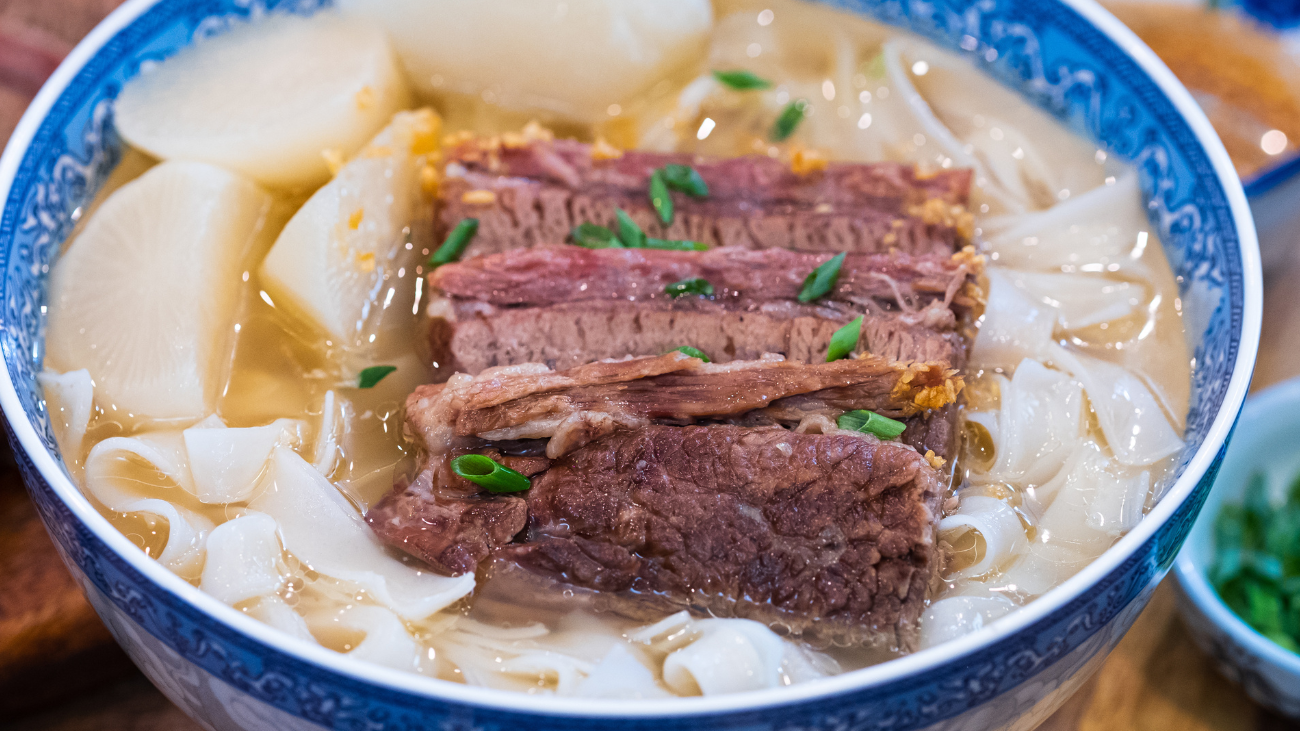Cantonese Braised Beef Noodle Soup (清汤牛腩粉)
Rated 4.0 stars by 18 users
Category
Beef
Author:
This classic Cantonese beef noodle is dedicated to the clean broth and purest beef flavor. The broth got a light sweet aftertaste from the daikon radish and the Gan Cao slices. The daikon radish also has a mildly peppery taste, making the beef flavor stand out even more. Even though it looks like Vietnamese pho, they are different. The Vietnamese pho broth is much sweeter; the sweetness comes from the onion and maybe some sugar. It usually serves with lime, basil, chilies, and bean sprouts, while Chinese ho fun is only topped with diced scallions, garlic oil, and maybe some pickles.

Ingredients
For Braising the Beef
- 2 lbs of beef Brisket
- 1.5 lbs of beef bones
- 1/2 of a cinnamon stick
- 1 star anise
- 2 bay leaves
- 2 cloves
- 1/2 a black cardamom
- 1 piece of tangerine peel
- 2 pieces of Gancao optional
- 4 cloves of garlic cloves peeled
- 5 slices of ginger
- 2 scallions
- 2.5 liters of water
For the Garlic Oil
- 1/4 cup of minced garlic
- 1/4 cup of oil
Others
- 2.5 lbs of daikon radish
-
5 tbsp fish sauce
- 3-4 servings of Ho Fun
- Diced scallions as garnish
Products Used
Directions
Braise the Beef
Soak the brisket and beef bones in water and leave them in the fridge overnight. The soaking is optional; it draws out some of the myoglobin from the meat and gives you a clear broth.
- Fill a big pot with lots of water, then add the brisket and the beef bones. Partially put on the lid to prevent overflowing. Turn the heat to high and bring it to a boil.
- Turn off the heat, then remove the brisket and bones from the pot. Discard the blanching water or keep it for other meals because we don't need the water for this recipe.
- Preheat a clay pot or stockpot. Add oil and saute the ginger, garlic, and scallions until fragrant. Keep the scallions whole instead of cutting them into stalks so they will be easier to discard later.
- Add 2.5 liters of water and bring it to a simmer.
- Put the cinnamon stick, star anise, bay leaves, cloves, black cardamon, dried tangerine peel, and Gancao into a spice bag.
- Add the brisket, bones, and spice bag to the clay pot. Turn the heat to the lowest and simmer for 2 hours. The heat needs to be low enough that you only see some small simmering activities. We call it "虾眼水," which means the size of the bubbles is like the size of the prawn eyes. Every stove is different. Please come back once in a while to monitor the heat and ensure the pot is not boiling while you are not looking; otherwise, the broth will turn out cloudy.
Make the Garlic Oil
Put the minced garlic in a strainer, rinse it under running water, and then shake off the excess water without dabbing it with paper towels. A little bit of moisture is necessary to prevent the garlic from burning.
- Add the garlic to a saucepot along with 1/4 cup of oil. Stir constantly over low heat for 8-10 minutes or until the garlic bits are slightly golden. Due to the water content, the oil will be foamy while sauteing, which hinders you from checking the color. Please spoon the garlic bits for a better view.
- Turn off the heat and set the garlic oil aside to cool. The rest of the heat will continue to fry the garlic and darken it into a full golden brown color.
- Why Rise The Garlic? When the garlic is crushed and chopped, it releases a sticky chemical called mercaptans, which we are trying to eliminate because it will bring a bitter taste when deep-fried.
Cook the Daikon Radish
Peel the daikon radish and cut it into big chunks using the roll-cutting technique.
- Souped Up Experiences - I found that the daikon radish in the USA is less sweet than the ones I get in China, giving the soup a bitter aftertaste. The skin contains most of the bitter elements, so please double peel the skin if needed for a better taste.
- Add the daikon radish into the pot and season the soup with fish sauce, then continue to simmer on low heat for 30 minutes.
Cook the Noodles and Serve
Soak the ho fun noodles in warm water for 5-8 minutes or until soft.
- Meanwhile, take the beef out of the broth and let it cool for a few minutes. Then, slice the beef into thick slabs.
- Discard the aromatics, the spice bag, and the bones. You can leave the radish in the soup. Optionally, sieve out the fat bits and the impurities to make sure the broth is clear and transparent.
- Bring the broth to a simmer and add the soaked noodles, then cook for a minute. Unlike wheat noodles, rice noodles don't release that much starch, so it is fine to cook them in the same broth.
- To assemble the noodle soup, add the noodles and broth to a big serving bowl; top with a few pieces of beef, radish, and some Chinese pickles; add a drizzle of garlic oil and sprinkle some diced scallions as garnish.
Recipe Video
Recipe Note
The dried tangerine peel (陈皮 chén pí) can be replaced with fresh lemon or orange peel. Be sure to remove the withe pith before using it;The Gancao (甘草 gān cǎo), AKA Liquorice Root, gives the soup a lightly sweet aftertaste. It is optional; you can replace it with 2 tsp of sugar or two drops of monk fruit extra.The daikon radish (白萝卜 bái luó bo) is the must-have item for beef soup in Cantonese cuisine. If you don't like it or you don't have access to buy it, use carrot instead.Ho Fun (河粉 hé fěn) is wide flat rice noodles, often found as Vietnamese pho noodles. If you don't have it, use any noodles that you have available. The taste might be different, but still delicious.








































































